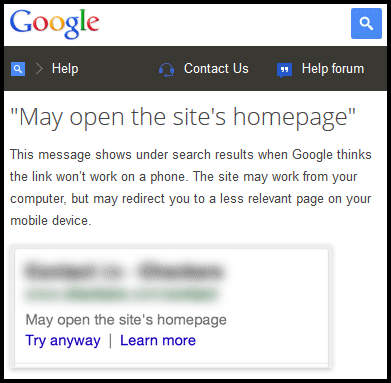
Google recently implemented new policies regarding mobile websites that could, and will zap you from the search results if you've implemented a particular setting with your mobile website.
They've changed their smartphone guidelines several times since 2010, but this is the first time that their policy change will penalize you for not implementing a mobile website correctly.
Originally they recommended that you create a mobile website that would be maintained side by side with your desktop site. This idea was very difficult to implement because there is a significant extra cost of labor development to set up a side-by-side mobile website.
As a result, an entire industry of mobile website builders sprung up from this recommendation. These mobile website builders will read your website and automatically generate a stand-alone version of your website tuned for smartphones. You then simply add a small bit of JavaScript to your desktop website that will detect and automatically transfer a user from the desktop to the mobile version.
The most popular mobile website builder is DudaMobile, followed by MobDis. You can find a review of 12 mobile website builders here
However, even with the availability of these convenient mobile website builders, most businesses were ignoring the benefits that mobile websites gave to customers.
Google then suggested that you could change your content management system (CMS) to display a desktop website or a mobile website depending on what type of device was detected. The major benefit of this is that you can specifically program your CMS to use smaller graphics and less code for the mobile devices. This is called "Dynamic Serving."
But again, this type of dynamic website is hard to set up correctly because someone needs to resize the images for the mobile devices, and then test the layouts on the mobile devices.
Speaking from experience, I know that many website programmers are forced to take short cuts because the website development budget isn't adequate enough. Using a technique called "media sensing" a programmer was able to figure out how to change the look of a website automatically depending on the screen size rather than the device type. This is what we call "responsive website design."
With a responsive design, you are able to apply a simple jewelry website templates to your website that was pre-programmed to show each web page however the original designer laid out the page. Most responsive website templates don't work perfectly out-of-the-box and usually need a lot of tweaking and testing.
Of the 3 methods, responsive websites are the least expensive to set up and have taken the world by storm. This is currently Google's recommended configuration.
The above suggested mobile website configurations are intended for smartphones. Google had given up on feature phones and websites built for feature phones. In fact, Google Analytics removed the ability to track feature phone websites. For you techies out there, this pretty much means the complete end-of-life for the WAP language method of programming very lightweight mobile websites.
Now let me explain what has changed, and why you might be zapping yourself from search results.
Each of the 3 above methods of designing mobile websites are valid; and when implemented correctly, they will satisfy users very well. My dislike of responsive website design is that you are using a lot of 3G and 4G bandwidth to send bloated code that's not needed on a smartphone.
The dynamic served websites have a lot of good potential, but there are few content management systems that support this type of system.
As of this writing, I like the separate mobile website the most because of the inherent tracking you can have with a mobile domain name. Responsive websites and dynamic content don't allow for different domain names. Using these separate websites, I can capture a lot of raw data and then come up with a good amount of business intelligence from it.
But there's a problem with separate mobile websites... As I said above, when you purchase a separate mobile website from one of the website builder companies, they will give you a JavaScript to add to the header of all your web pages. That JavaScript will detect a smartphone and redirect the user to the mobile website.
Usually that redirect will land the user on the home page of the mobile site, which isn't very helpful. Additionally, the websites created by those mobile website builders don't usually have all the same pages and content as your desktop website.
Google doesn't like this approach at all. They want users to be redirected to a mobile version of the same page they saw in the search results, which reinforces their recommendation of responsive website designs.
As of May 2014, for those of you using the home page redirect method, Google will now display a message on the mobile SERPs.
Here's a screen shot of the help page they set up about their new policy:

I'd have to assume that a smartphone user would avoid tapping that link in the mobile SERPs when they see it, which means your organic traffic will drop.
Referring back to the mobile usage statistics I published in May 2014, you'll see that 28% of users are on mobile and 12% are on tablets. That's 40% that would see the above message and potentially skip your organic listing.
If you are using website builders like DudaMobile and MobDis, you will have to make sure those systems recreate every page of your desktop site. Then make sure the JavaScript redirects correctly.
But Google's new policy has one more addendum that's even trickier. They stipulate that a smartphone user must be given the ability to flip-flop back and forth between the mobile site and the desktop site whenever they want. You would have to check with your mobile website builder to find out if this is even possible.
The CMS I use has the built-in ability to manage a desktop and a mobile site within one system, and on the same web server. This allows for the easy creation of all pages on mobile and desktop/tablet with that ability to flip-flop.
The bottom line here is that Google is not playing games any more, and they are sending a clear message for you to clean up your website with the correct mobile website methods; otherwise you will lose business.








